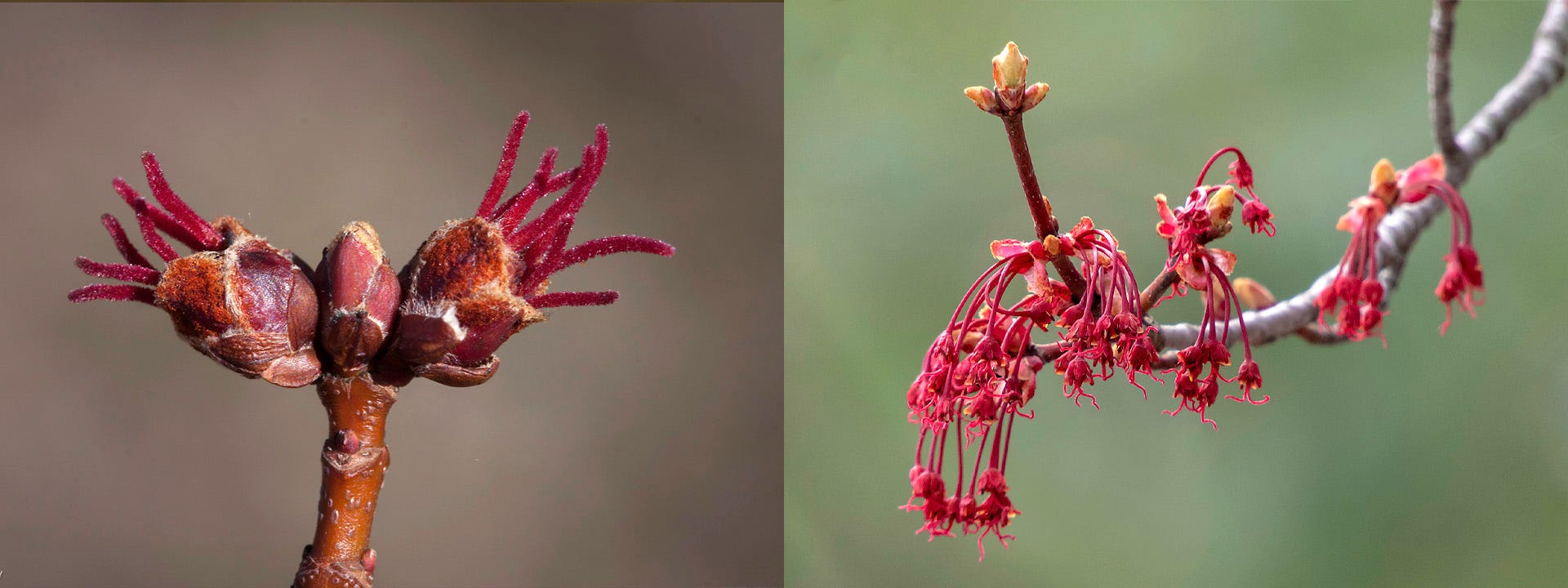Red Alert
Springtime and sexual identity expressed in maple flowers — now on display across much of the eastern United States
ACROSS MUCH of the eastern United States, our earliest hints of spring are not green — they are red: an explosion of maple flowers now on display and moving north.
From my home in Vermont, I’ve embarked on a roadtrip into the southeastern U.S. to meet up with spring. Along the way, from roughly New York to North Carolina (where I am now encamped), the maples are breaking out in flowers like those in the images above.
Flowers? Where are their petals? These have none, which reveals their raw displays of reproduction. And when it comes to sexuality among maples, well, it’s dynamic to say the least. Some trees are entirely male. Some are female. Some are both. Some even switch.
The left image above shows female flowers of a Silver Maple (Acer saccharinum). Emerging from the buds are the wiry ruby styles, whose tips (stigmas) receive pollen carried on the winds from male flowers on another tree. Above on the right, dangling on long stalks, are flowers on a female Red Maple (Acer rubrum) similarly showing their wiry styles.
Male flowers on their own trees are similar. Their pollen-producing anthers extend on filaments from the buds. On the left below are male flowers from a Silver Maple. On the right is a quick iPhone shot of mostly spent anthers in Washington, D.C., last week (proof that all this happens in cities as well, and that it’s happening now before the leaves emerge).
But also know that nature is nothing if not complicated, especially when it comes to reproduction. As Silver Maples get old, their unisexual flowers (either entirely male or female on a given tree) can shift to become bisexual. You can see that in my image below: ruby female styles just starting to emerge (like in the top left image), but deeper in each flower bud below you can just make out bunches of brown anthers yet to emerge (and looking a bit like chubby hot-dog buns). (Click and zoom that shot for a better view.)
Among unisexual Red Maples, some can become sexually fluid. A Red Maple that produced only female flowers for years might one year produce some male flowers as well. And entirely male Red Maples certain years might bear some female flowers.
How might you yourself witness all this flowering and reproduction? These final two images feature Red Maple trees in bloom: ruby female flowers and orangish male flowers (owing to yellow pollen) on separate trees (although their branches overlap). (Click for a bigger view.)
So please look up — now (or in late March and April in northern-tier states and eastern Canada). Spring is emerging before the leaves — and perhaps before you yourself might have noticed.


References and Notes
For more on maple sexual fluidity, I suggest Richard B. Primack’s excellent article titled The Sex Life of the Red Maple published in Arnoldia, the quarterly magazine of Harvard’s Arnold Arboretum.
Thanks to my friend and colleague Kent McFarland for that top shot of female Silver Maple flowers.
In botany parlance, we call unisexual plants (individuals that are either male or female) “dioecious” — a counter-intuitive term that means the male and female reproductive parts are borne of “two houses.” (In another words, it takes two separate plants to reproduce.) Bisexual plants are “monoecious” — male and female flowing parts existing together of “one house.”
Incidentally, I’m using “fluidity” because the botany terms established for some of this stuff can be a challenge: polygamodioecious or polygamomonoecious.
Across Europe (and points east), the common native maples — including Sycamore Maple (Acer pseudoplatanus), Norway Maple (Acer plantanoides) and Field Maple (Acer campestre) — tend to flower in yellows and greens after the leaves emerge. The same is true for Bigleaf Maple (Acer macrophyllum) in the far western U.S. and Striped Maple (Acer pensylvanicum) in the East.





Thanks Bryan. How I love those tiny early red flowers welcoming us to another spring. M.
What a beautiful way to celebrate Earth Day. Thank you Bryan! So glad to read someone talking about all the reds of spring. The best time of year to see immediately where poison ivy is growing! A question: Is the source of all this red pigment in plants anthocyanins, including in the maple flowers? Or is the red of these flowers produced by something else?